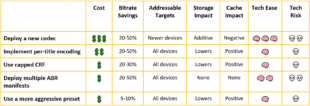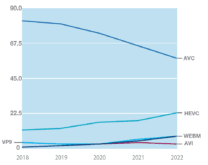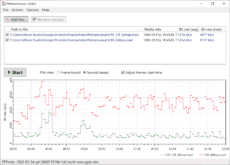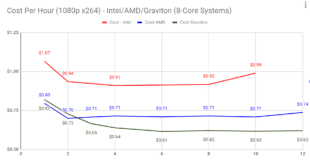I just posted a new lesson to the Streaming Media 101 course on AI in encoding, production, and customer experiences. The lesson is free to all current students; here’s the description. Lesson Description In this lesson, you will learn about the dynamic role of artificial intelligence in transforming media encoding, production processes, and customer experiences. The lesson offers an overview …
Read More »Codec Update for Streaming Media 101 Course
I’ve just posted a major codec update to my course, Streaming Media 101: Technical Onboarding for Streaming Media Professionals. The update incorporates the latest on H.264, HEVC, VP9, AV1, LCEVC, and VVC, with EVC excluded since it’s made such little progress on productization and royalty status to date (though the MPAI is doing some interesting things). The update totals about …
Read More »The Quality Cost of Low-Latency Transcoding
While low-latency transcoding sounds desirable, low-latency transcode settings can reduce quality and may not noticeably impact latency. Reducing latency has been a major focus for many live producers, and appropriately so, particularly for events that viewers can watch via other media, like sporting events available through satellite or cable TV. However, it’s important to understand that transcoding latency contributes minimally …
Read More »Five Codec-Related Techniques to Cut Bandwidth Costs
The mandate for streaming producers hasn’t changed since we delivered RealVideo streams targeted at 28.8 modems; that is, we must produce the absolute best quality video at the lowest possible bandwidth. With cost control top of mind for many streaming producers, let’s explore five codec-related options to cut bandwidth costs while maintaining quality. For each, I’ll consider the factors summarized …
Read More »Codec Royalties on Content and the Jaws Moment
I was raised in a beachfront commuter town about 60 miles south of Manhattan and five miles north of Springsteen’s Asbury Park. I went to Seashore Day Camp years 8-13, swimming laps in the pool each morning and clowning around in the ocean each afternoon. I spent middle school and high school in the Atlantic as often as possible, swimming, …
Read More »Telestream Resurrects encoding.com’s Global Media Format Report
Telestream resurrects encoding.com’s Global Media Format Report to provide valuable data on codec usage and other production details. For years, encoding.com’s Global Media Format Report provided a key set of data points on codec usage and other topics from the prior years encoding production. Since encoding.com was the first and remains one of the largest cloud encoding providers, this data …
Read More »Video Codec Quick Reference Guide
This article provides a quick reference for video codec details from H.264 to LCEVC, excluding EVC, because so little progress has been made on productization. Codec Overview Starting at the top, the year released emphasizes how long H.264 has remained the dominant codec, as evidenced by ReThink’s 2023 usage rate of about 72%. Browser penetration, as measured by CanIuse, is …
Read More »Replace Bitrate Viewer with FFBitrateViewer
Recently I was asked to visually illustrate the data rate difference between two HEVC files, one encoded with CBR at 6 Mbps, the other using capped CRF with the same cap. Of course, everyone’s go-to bitrate visualization viewer has always been Bitrate Viewer, which does a great job displaying the bitrate of a single H.264-encoded file. Unfortunately, it can’t input …
Read More »B-Frames, Ultra Low-Latency Encoding, and Parking Lot Rules
One of my sweetest memories of bringing up our two daughters was weekly trips to the grocery store. Each got a $5.00 bribe for accompanying their father, which they happily invested in various tchotchkes that seldom lasted the week. When we exited the car, “parking lot rules” always applied, which meant that each daughter held one of Daddy’s hands for …
Read More »Which is the Best AWS CPU for FFmpeg?
If you encode with FFmpeg on AWS, you probably know that you have three CPU options: AMD, Graviton, and Intel. Which is the best AWS CPU for FFmpeg? This article reveals all. For those in a hurry, it’s Graviton for x264 and AMD for x265, often by a significant margin. But the devil is always in the details, and if …
Read More » Streaming Learning Center Where Streaming Professionals Learn to Excel
Streaming Learning Center Where Streaming Professionals Learn to Excel












